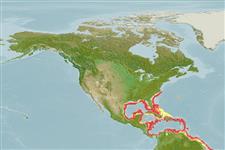Elasmobranchii (sharks and rays) >
Rajiformes (Skates and rays) >
Rajidae (Skates)
Etymology: Leucoraja: Greek, leykos = white + Latin, raja = a fish, Raja sp. (Ref. 45335).
Environment: milieu / climate zone / depth range / distribution range
Ecology
Marine; demersal; depth range 53 - 588 m (Ref. 106604). Tropical
Western Central Atlantic: northern Gulf of Mexico to Nicaragua. Regarded as junior synonym of Raja garmani, but findings unpublished (Ref. 3824).
Length at first maturity / Size / Weight / Age
Maturity: Lm 37.5, range 35 - 40 cm
Max length : 44.0 cm TL male/unsexed; (Ref. 106604)
Upper surface disk is densely freckled with small dark brown or pale brown and whitish spots, not arranged in rosettes (Ref. 7251). Spots on tail grouped in form about five or six prominent bars. Light and dark spots on dorsal and caudal fin. Lower surface whitish (Ref. 6902).
Oviparous (Ref. 50449). Eggs have horn-like projections on the shell (Ref. 205).
Life cycle and mating behavior
Maturity | Reproduction | Spawning | Eggs | Fecundity | Larvae
Oviparous, paired eggs are laid. Embryos feed solely on yolk (Ref. 50449).
McEachran, J.D. and K.A. Dunn, 1998. Phylogenetic analysis of skates, a morphologically conservative clade of elasmobranchs (Chondrichthyes: Rajidae). Copeia 1998(2):271-290. (Ref. 27314)
IUCN Red List Status (Ref. 130435: Version 2024-1)
Threat to humans
Harmless
Human uses
Fisheries: minor commercial
Tools
Special reports
Download XML
Internet sources
Estimates based on models
Preferred temperature (Ref.
123201): 13.9 - 23.5, mean 19.7 °C (based on 83 cells).
Phylogenetic diversity index (Ref.
82804): PD
50 = 0.5000 [Uniqueness, from 0.5 = low to 2.0 = high].
Bayesian length-weight: a=0.00339 (0.00168 - 0.00685), b=3.25 (3.08 - 3.42), in cm total length, based on LWR estimates for this Genus-body shape (Ref.
93245).
Trophic level (Ref.
69278): 3.6 ±0.1 se; based on size and trophs of closest relatives
Resilience (Ref.
120179): Low, minimum population doubling time 4.5 - 14 years (Fec assumed to be <100).
Fishing Vulnerability (Ref.
59153): Low to moderate vulnerability (34 of 100).
Nutrients (Ref.
124155): Calcium = 28.4 [3.7, 536.4] mg/100g; Iron = 0.809 [0.075, 9.456] mg/100g; Protein = 15.7 [13.7, 17.7] %; Omega3 = 0.352 [0.141, 0.919] g/100g; Selenium = 57.8 [10.7, 304.1] μg/100g; VitaminA = 12.1 [0.9, 129.1] μg/100g; Zinc = 0.77 [0.04, 8.92] mg/100g (wet weight);
